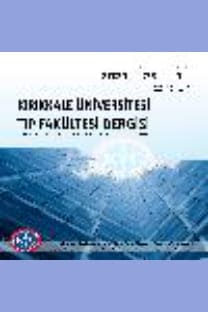Farklı Adeziv Sistemlerin Dentindeki Mikrogerilim Bağlanma Dayanımlarının İncelenmesi
Pages 01-05
-,
___
- 1. Frankenberger R, García-Godoy F, Lohbauer U, Petschelt A, Krämer N. Evaluation of resin composite materials. Part I: in vitro investigations. Am J Dent 2005; 18: 23-7.
- 2. Niu Y, Ma X, Fan M, Zhu S. Effects of layering techniques on the micro-tensile bond strength to dentin in resin composite restorations. Dent Mater 2009; 25: 129-34.
- 3. Dalli'Magro E, Sinhoreti MA, Correr AB, Consani RL, Sicoli EA, Mendoça MJ, CorrerSobrinho L. Effect of different modes of light modulation on the bond strength and knoop hardness of a dental composite. Braz Dent J 2008;19: 334-40.
- 4. Giachetti L, Scaminaci Russo D, Bambi C, Grandini R. A review of polymerization shrinkage stress: current techniques for posterior direct resin restorations. J Contemp Dent Pract 2006; 7: 79-88.
- 5. Van Meerbeek B, De Munck J, Yoshida Y, Inoue S, Vargas M, Vijay P, Van Landuyt K, Lambrechts P, Vanherle G. Buonocore memorial lecture. Adhesion to enamel and dentin: current status and future challenges. Oper Dent 2003; 28: 215-35.
- 6. Versluis A, Tantbirojn D, Douglas WH. Do dental composites always shrink toward the light? J Dent Res 1998; 77: 1435-45.
- 7. Guzmán-Armstrong S, Armstrong SR, Qian F. Relationship between nanoleakage and microtensile bond strength at the resin-dentin interface. Oper Dent 2003; 28: 60-6.
- 8. Okuda M, Pereira PN, Nakajima M, Tagami J, Pashley DH. Long-term durability of resin dentin interface: nanoleakage vs. microtensile bond strength. Oper Dent 2002; 27: 289-96
- 9. Foxton RM, Melo L, Stone DG, Pilecki P, Sherriff M, Watson TF. Long-term durability of one-step adhesive-composite systems to enamel and dentin. Oper Dent 2008; 33: 651-7.
- 10. Leirskar J, Oilo G, Nordbø H. In vitro shear bond strength of two resin composites to dentin with five different dentin adhesives. Quintessence Int 1998; 29: 787-92.
- 11. Uekusa S, Tsubota K, Tonegawa M, Tsuchiya H, Iwasa M, Kawamoto R, Takamizawa T, Miyazaki M. Microtensile bond strengths of single-step self-etch adhesive systems to bovine dentin. J Oral Sci 2007; 49: 183-9.
- 12. Yoshiyama M, Sano H, Ebisu S, Tagami J, Ciucchi B, Carvalho RM, Johnson MH, Pashley DH Regional strengths of bonding agents to cervical sclerotic root dentin. J Dent Res 1996; 75: 1404-1413.
- 13.Burrow MF, Sano H, Nakajima M, Harada N, Tagami J. Bond strength to crown and root dentin. Am J Dent 1996; 9, 223-229.
- 14. Ogata M, Okuda M, Nakajima M, Pereira PN, Sano H, Tagami J.Influence of the direction of tubules on bond strength to dentin. Oper Dent 2001; 26, 27-35.
- 15. Miyazaki M, Oshida Y, Xirouchaki L.Dentin bonding system. Part I: literature review. Biomed Mater Eng 1996; 6: 15-31
- 16. Neelima L, Sathish ES, Kandaswamy D; Bupesh. Evaluation of microtensile bond strength of total-etches, self-etch, and glass ionomer adhesive to human dentin: an in vitro study. Indian J Dent Res 2008; 19:129-33.
- 17.Inokoshi S, Hosoda H, Harnirattisai C, Shimada Y. Interfacial structure between dentin and seven dentin bonding systems revealed using argon ion beam etching. Oper Dent 1993; 18: 8- 16
- 18.Ceballos L, Camejo DG, Victoria Fuentes M, Osorio R, Toledano M, Carvalho RM, Pashley DH.Microtensile bond strength of total-etch and self-etching adhesives to caries-affected dentine. J Dent 2003; 31: 469-77.
- 19.Inoue S, Van Meerbeek B, Vargas M, Yoshida Y, Lambrechts P, Vanherle G. Adhesion mechanism of self-etching adhesives. In:Tagami J, Toledano M, Prati C, et al., editors. Advanced Adhesive Dentistry Cirimido, Italia 2000; 131- 48.
- 20. Soares FZ, Rocha Rde O, Raggio DP, Sadek FT, Cardoso PE. Microtensile bond strength of different adhesive systems to primary and permanent dentin. Pediatr Dent 2005; 27(6):457-62.
- 21. Purk JH, Healy M, Dusevich V, Glaros A, Eick JD. In vitro microtensile bond strength of four adhesives tested at the gingival and pulpal walls of Class II restorations. J Am Dent Assoc 2006; 137: 1414-8.
- 22.Brackett WW, Ito S, Nishitani Y, Haisch LD, Pashley DH. The microtensile bond strength of self-etching adhesives to ground enamel. Oper Dent 2006; 31: 332-7.
- 23. Bowen RL, Cobb EN. A method of bonding to dentin and enamel. J Am Dent Assoc 1983; 107: 734-6
- ISSN: 2148-9645
- Yayın Aralığı: 3
- Başlangıç: 1999
- Yayıncı: KIRIKKALE ÜNİVERSİTESİ KÜTÜPHANE VE DOKÜMANTASYON BAŞKANLIĞI
Tibial Eminentia’nın Okronozise Bağlı Osteokondral Kırığı
Birhan OKTAŞ, , Arif ASLAN, Fatih SEVİNC, Meriç ÇIRPAR
Bir Olgu Nedeniyle Yenidoğanda Ölümcül Seyirli Boğmaca Enfeksiyonu
Özgül Tunç AKBAŞ, , Didem ALİEFENDİOĞLU, Cihat ŞANLI, Güzide KURT
Aybala Ağaç AY, , Kuzey AYDINURAZ, Vural SÖZEN, Oral SAYGUN, Çağatay Erden DAPHAN
Karın Ön Duvari Defektlerinde Antenatal Tanı ve İzlem
Bruksizm Tanı ve Tedavisinde Güncel Yaklaşımlar
Tırnak Yeme Alışkanlığının Temporomandibular Rahatsızlıklar Üzerindeki Etkilerinin Araştırılması
Farklı Adeziv Sistemlerin Dentindeki Mikrogerilim Bağlanma Dayanımlarının İncelenmesi
, İşıl ŞAROĞLU SÖNMEZ, Aylin AKBAY OBA, Merve ERKMEN ALMAZ
